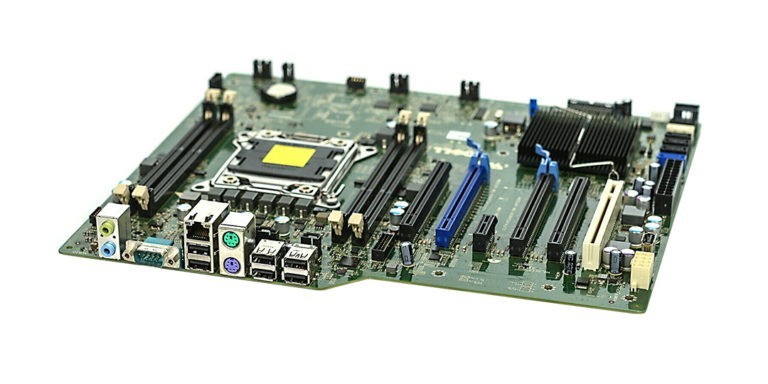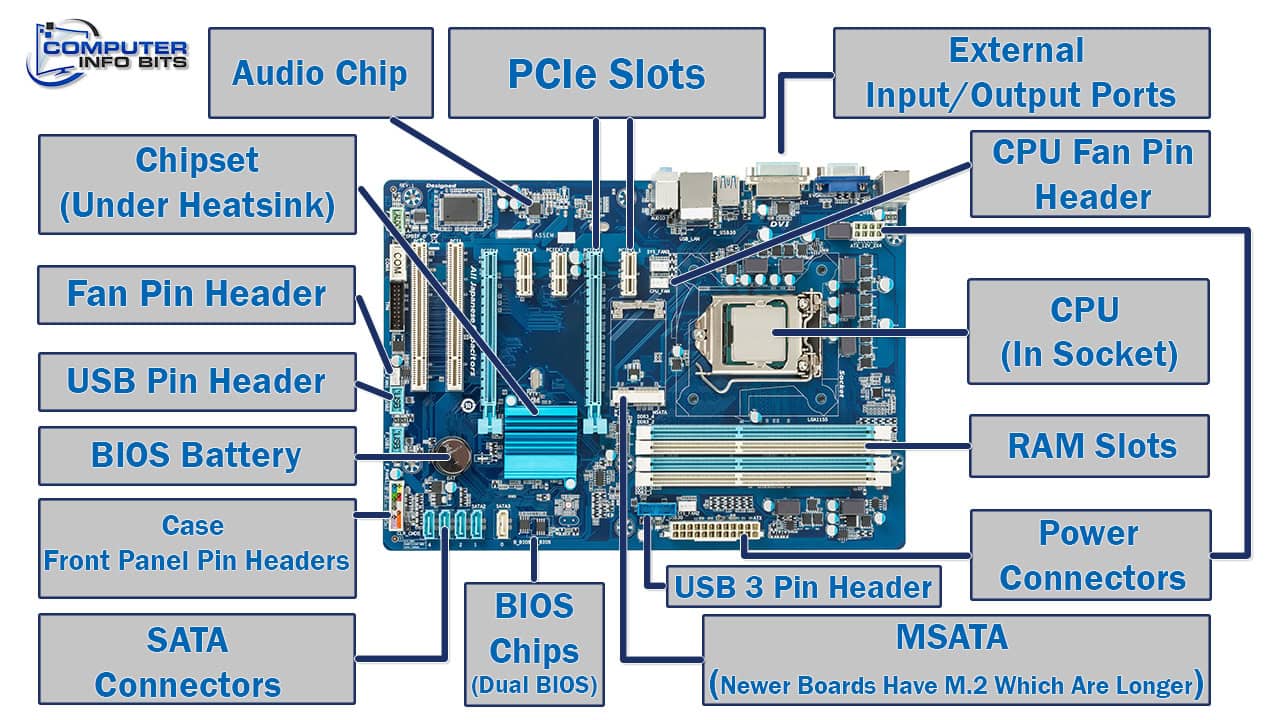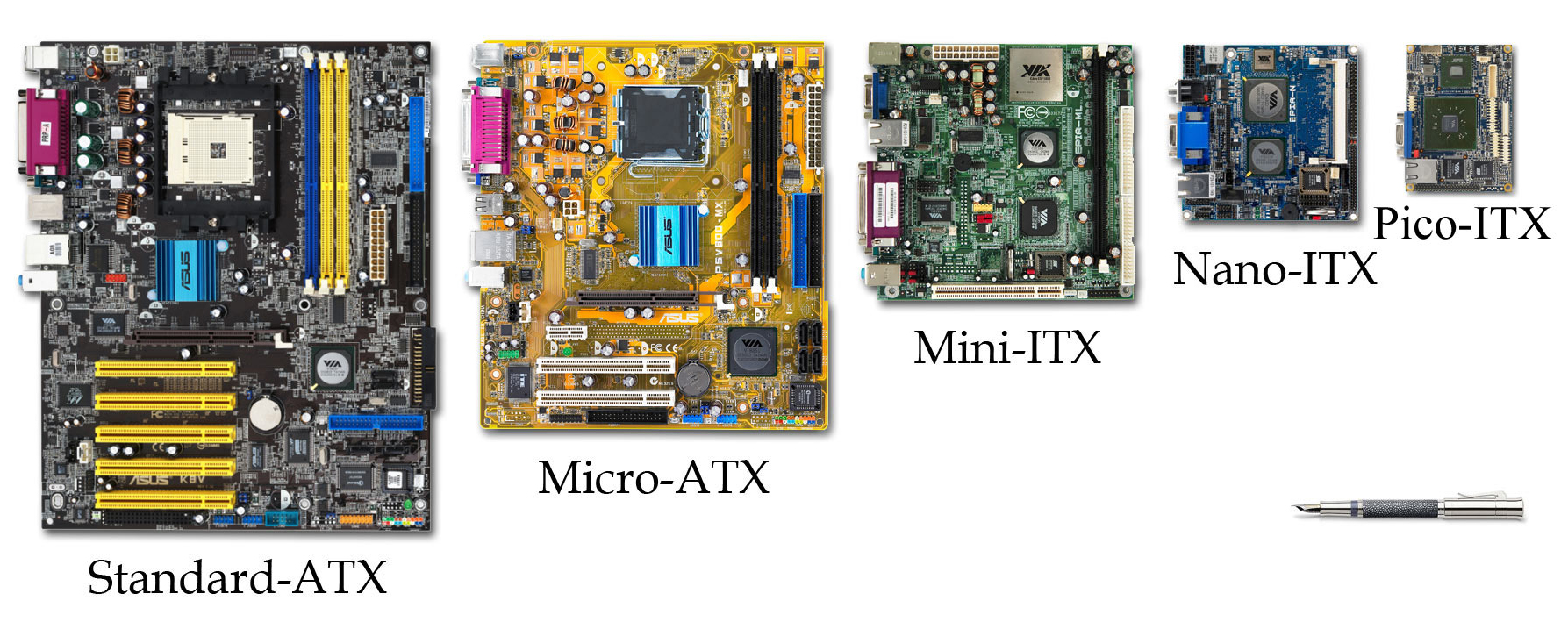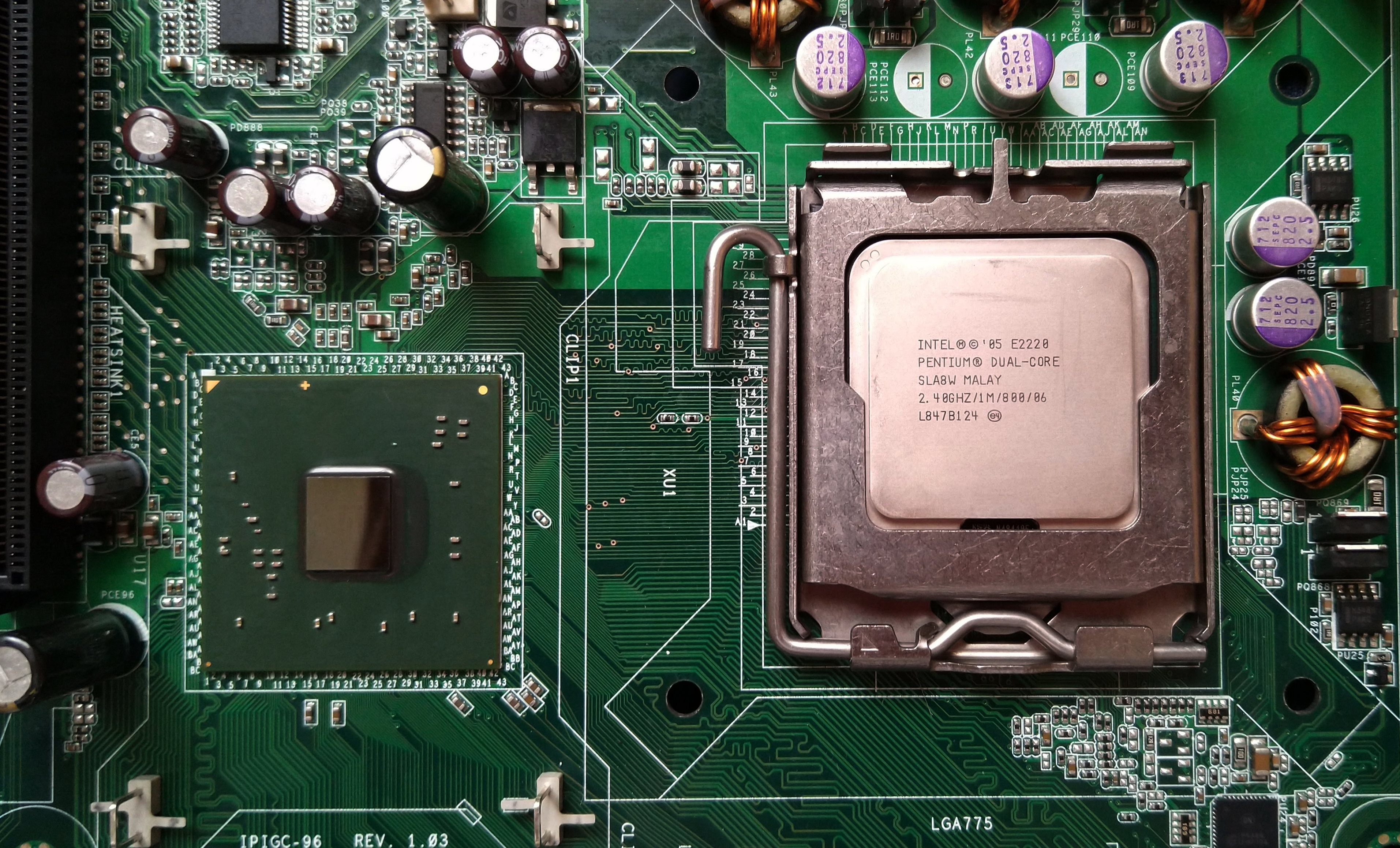Comparative Study On Different Types Of Motherboards
From Wikibytes, the computer encyclopedia.

The motherboard is the heart of a PC. It is often regarded as the "spine" or "backbone" of the system due to its essential role in connecting and facilitating communication between various computer components (Volle, 2023). While manufacturers may use terms like system board, planar board, baseboard, or main board—and Intel refers to its versions as desktop boards—the motherboard is universally recognized as the defining element of a computer (Thompson & Thompson, 2009). The image depicts the Dell Precision T3600 system motherboard. Manufactured in 2012, this motherbaord a component used in professional CAD workstations (Wieclaw, 2019).
Constructed from a rigid, non-conductive base material, typically plastic, a motherboard features intricate circuits formed by thin copper or aluminum "traces" that link its components. These circuits lead to slots where key hardware such as the CPU, RAM, storage drives, and expansion cards, including graphics cards and sound adapters, are installed. Additionally, the motherboard includes sockets for connecting hard drives and other devices via cables, as well as ports for external peripherals like monitors and input devices (Volle, 2023).
Discussion
The different types of motherboards can be distinguished by various features, including their physical design, collectively referred to as the form factor, the chipset that determines the motherboard's functionality, the processors it is compatible with, the BIOS it employs, and the types of internal and expansion buses it supports (Thompson & Thompson, 2009). Understanding these components of a motherboard and their various functions is crucial for anyone looking to build, upgrade, or troubleshoot their system. The image presents the basic components of a motherboard (Strydom, 2024).

Form Factor
Motherboards differ in size, shape, placement of mounting holes, type of power supply connectors, and the types and locations of ports. These variations collectively define the motherboard's form factor (Thompson & Thompson, 2009). A motherboard's form factor is a standard that specifies the dimensions of the motherboard for a personal computer. It defines how the motherboard fits within the case, including the placement of interfaces, ports, CPU socket, RAM slots, and the type of connector used to link the power supply (Поликарпова, 2015).

Chipsets
Just as the motherboard defines a PC, the chipset defines the motherboard. It determines key features such as the processors the motherboard can support, the types of RAM it is compatible with, the bus types and speeds it can handle, and whether it supports standards like AGP and USB (Thompson & Thompson, 2009). The image below shows an Intel Pentium Dual-Core E2220 2.40 GHz processor paired with an Intel i945GC Express Chipset, mounted on an Intel D945GCCR motherboard (Villa, 2019). The chipset plays a vital role in system performance by managing communication between the processor and external devices. In x86-based computers, the term "chipset" often refers to the combination of two chips: the northbridge and southbridge. The northbridge connects the CPU to high-speed devices like RAM and graphics controllers, while the southbridge links to slower peripheral buses (e.g., PCI or ISA). Many modern southbridges also include integrated peripherals, such as Ethernet, USB, and audio devices (Schmid, 2002).

Types of Motherboards
Obselete Form Factors
Obsolete form factors today were the first standards of motherboards.
• Full AT (Advanced Technology), corresponding to the original IBM AT computer.
• Baby AT, introduced by IBM in 1984, was smaller than the AT form factor and used fewer chips, with a 16-bit system.
• LPX (Low Profile eXtension) and Mini-LPX, developed by Western Digital in 1987, featured connectors arranged to keep expansion cards parallel to the system board, allowing for smaller, low-profile cases (Поликарпова, 2015).
| Form Factor | Build | CPU Slots | Memory Slots | Chipsets | BIOS | PCI Slots | SATA | Builtin Features |
|---|---|---|---|---|---|---|---|---|
| Full AT (Advanced Technology) | 12 × 13.8 in (305 × 351 mm) | 1 | 2 - 4 | Northbridge: basic memory and CPU support, Southbridge: limited I/O functionality | Legacy BIOS | 5 - 7 | 0 - 2 | Legacy ports (serial, parallel), basic functionality |
| Baby AT | 8.5 × 9-10 in (215.90 × 228.60- 254 mm) | 1 | 2 - 3 | Northbridge: CPU and RAM controller, Southbridge: basic I/O management | Legacy BIOS | 4 - 6 | 0 - 2 | Smaller than Full AT, fewer expansion options |
| LPX (Low Profile eXtension) and Mini-LPX | 13 × 9 in (330 × 229 mm) | 1 | 2 - 3 | Northbridge: integrated CPU/memory, limited I/O support | Legacy BIOS | 2 - 4 | 0 - 2 | Low-profile, parallel PCI slots |
Modern Form Factors
Modern form factors are widely used today in motherboard design.
• ATX (Advanced Technology eXtended), released by Intel in July 1995, replaced the older AT form factor, is used in systems like mini tower and full tower cases, ideal for users requiring extensive expansion capabilities, such as installing multiple GPUs, extra storage devices, and PCIe cards for demanding tasks like gaming or video editing (GeeksforGeeks, 2024).
• Micro-ATX (mATX), introduced by Intel in December 1997, is designed for budget-friendly, compact systems, typically for office use and not ideal for gaming, suitable for users who don’t need extensive future upgrades or multiple GPUs, great for budget builds or home/office computers (GeeksforGeeks, 2024).
• NLX (New Low Profile eXtended), introduced by Intel in November 1997, it features USB ports on the front panel and connectors arranged in two rows (Поликарпова, 2015).
| Form Factor | Build | CPU Slots | Memory Slots | Chipsets | BIOS | PCI Slots | SATA | Builtin Features |
|---|---|---|---|---|---|---|---|---|
| ATX (Advanced Technology eXtended) | 12 × 9.6 in (305 × 244 mm) | 1 | 2 - 4, sometimes up to 8 RAM slots (DIMM) | Northbridge: high-performance controllers, Southbridge: modern I/O controllers | UEFI/Legacy BIOS | Up to 7 expansion slots, 1 to 4 (GPU) | 4 - 12 | Optimized airflow, integrated audio/network |
| Micro-ATX (mATX) | 9.6 × 9.6 in (244 × 244 mm) | 1 | Up to 4 RAM slots (DIMM) | Northbridge: mainstream CPU/memory support, Southbridge: modern I/O controllers | UEFI/Legacy BIOS | Up to 3 (GPU) | 4 - 8 | Compact size, basic to high-end features |
| NLX (New Low Profile eXtended) | 10 × 8 in (254 × 203 mm) to 13.6 × 9 in (345 × 229 mm) | 1 | 2 - 4 | Northbridge: integrated northbridge, Southbridge: basic southbridge | Legacy BIOS | 2 - 3 | 2 - 4 | Edge connector for expandability, front I/O ports |
Prospective Form Factors
Prospective form factors are newer standards, emerging since 2000, are not yet widely adopted.
• Mini-ITX, developed by VIA Technologies in 2001, is a compact form with a soldered processor and passive cooling system, suitable for HTPCs, media centers, portable systems, compact builds (Wang, 2024).
• Nano-ITX, used for media devices and consoles, with components arranged on opposite sides of the board.
• Pico-ITX, designed for ultra-thin PCs and features integrated VIA C7 processors, graphics, and multiple I/O ports.
• Micro-BTX, developed using the technology MoDTin 2004, is designed for mobile processors (Поликарпова, 2015).
| Form Factor | Build | CPU Slots | Memory Slots | Chipsets | BIOS | PCI Slots | SATA | Builtin Features |
|---|---|---|---|---|---|---|---|---|
| Mini-ITX | 6.7 × 6.7 in (170 × 170) mm | 1 | Up to 2 RAM slots, (DIMM, SODIMM) | Northbridge: integrated with CPU, Southbridge: basic southbridge | UEFI/Legacy BIOS | 1 (GPU) | 2 - 6 | Small size, integrated CPU (often), basic I/O |
| Nano-ITX | 4.7 × 4.7 in (120 × 120 mm) | 1 (soldered) | 1 | Northbridge: integrated with CPU, Southbridge: minimal I/O controllers | UEFI/Legacy BIOS | 1 | 1 - 2 | Media-centric, passive cooling |
| Pico-ITX | 3.9 × 2.8 in (100 × 72 mm) | 1 (soldered) | 1 | Northbridge: integrated with CPU, Southbridge: minimal I/O controllers | UEFI/Legacy BIOS | 0 - 1 | 1 | Ultra-compact, minimal expandability |
| Micro-BTX | 10.5 × 10.4 in (266.70 × 264.16 mm) | 1 | 2 - 4 | Northbridge: enhanced CPU/memory handling, Southbridge: modern I/O controllers | UEFI/Legacy BIOS | 3 - 4 | 4 - 6 | Designed for improved cooling |
Other Prominent Form Factors
• Extended-ATX, bigger version of the ATX motherboard, suited for professionals running resource-heavy applications, such as 3D rendering, AI modeling, or server management (GeeksforGeeks, 2024).
• Mini-ATX, designed with MoDT (Mobile on Desktop Technology), which adapts mobile CPUs for lower power requirements and less heat generation.
• BTX (Balanced Technology eXtended), originally intended to be the replacement for the aging ATX motherboard form factor in late 2004 and early 2005.
• Pico-BTX, meant to miniaturize the BTX standard, share a common top half with the other sizes in the BTX line, but support only one or two expansion slots, designed for half-height or riser card applications.
| Form Factor | Build | CPU Slots | Memory Slots | Chipsets | BIOS | PCI Slots | SATA | Builtin Features |
|---|---|---|---|---|---|---|---|---|
| Extended-ATX | 12 × 13 in (305 × 330 mm) | 1 – 2, dual CPU support in some models | Up to 8 RAM slots | Advanced northbridge and southbridge chipsets | UEFI/Legacy BIOS | 6 - 8 | 6 - 10 | Workstation-class, multi-GPU support |
| Mini-ATX | 5.9 × 5.9 in (150 × 150 mm) | 1 | 2 - 3 | Northbridge: moderate performance controllers, Southbridge: basic southbidge | UEFI/Legacy BIOS | 2 - 3 | 2 - 4 | Smaller than ATX, moderate expandability |
| BTX (Balanced Technology eXtended) | 12.8 × 10.5 in (325 × 267 mm) | 1 | 2 – 3 | Northbridge: optimized performance design, Southbridge: modern I/O controllers | UEFI/Legacy BIOS | 4 - 7 | 4 – 8 | Optimized airflow, better thermals |
| Pico-BTX | 8 × 10.5 in (203 × 267 mm) | 1 | 1 - 2 | Northbridge: basic integration, Southbridge: limited southbridge | UEFI/Legacy BIOS | 1 - 2 | 1 - 2 | Compact BTX design, limited expandability |
How To Choose a Motherboard
These tables provides clear overview of the capabilities and features associated with each motherboard form factor, helping users make informed purhcasing decisions based on their needs for CPU power, memory capacity, and expansion options. Selecting the appropriate form factor is essential to ensure that a system meets user requirements while allowing for future upgrades and efficient cooling solutions. ATX is ideal for gamers and professionals, Micro ATX suits general users, and eXtended ATX is best for workstations and power users. Each form factor offers distinct advantages, making it important to choose based on your specific requirements (GeeksforGeeks, 2024). Поликарпова (2015) enumerates several rules when choosing the appropriate motherboard based on your needs:
1. Choose reputable manufacturers (such as ASRock, ASUS, Gigabyte, and MSI) to ensure quality and reliability.
2. Check important specifications like compatibility with processors, memory, and expansion slots.
3. Start with lower-cost options and evaluate their features and performance to stay within your budget.
4. Shortlist a few suitable models that meet your requirements and compare their prices.
5. Visit the manufacturers’ websites to review detailed information on each motherboard, including supported processors and operating systems.
6. Examine product images carefully, paying close attention to the number and types of connectors, as well as the cooling system.
7. Compare the pros and cons of each motherboard to make an informed decision.
Analysis/Reaction
References
buildcomputers.net. (n.d.). Motherboard form factors explained - guide to motherboard sizes. https://www.buildcomputers.net/motherboard-form-factors.html
Cobb, R. (2024, October 18). Types of motherboards: Form factors and features explained. Rocky MTN Ruby. https://rockymtnruby.com/types-of-motherboards/
GeeksforGeeks. (2024, September 12). Types of motherboards. https://www.geeksforgeeks.org/types-of-motherboards/
Schmid, P. (2002, July 16). Chipset Basics: Meaning And Functions. Tom’s Hardware. https://www.tomshardware.com/reviews/full-power,490-2.html
Strydom, M. (2024, June 20). Parts of a motherboard and all their functions. Computer Info Bits. https://computerinfobits.com/parts-of-a-motherboard-and-their-functions/
Thompson, R., & Thompson, B. F. (2009). PC hardware in a Nutshell. O’Reilly Media, Inc.
Villa, J. (2019, November 21). Intel Pentium Dual-Core E2220 2.40 GHz with Intel i945GC Express Chipset on an Intel D945GCCR motherboard [Photograph]. Own work.
Volle, A. (2023, April 21). motherboard. Encyclopedia Britannica. https://www.britannica.com/technology/motherboard
Wang, L. (2024, May 12). Different motherboard form factors explained: A comprehensive guide. PC Outlet. https://pcoutlet.com/parts/motherboards/different-motherboard-form-factors-explained
Wieclaw, M. (2019, October 1). Dell Precision T3600 system motherboard, used in professional CAD workstations. Retrieved from https://pcsite.co.uk/motherboard/
Поликарпова, Е. И. (2015). DEVELOPMENT OF MOTHERBOARD ARCHITECTURE. Печатается по решению Редакционно-издательского совета ФГБОУ ВПО «Хакасский государственный университет им. НФ Катанова», 235. https://inpo.khsu.ru/files/College/science/konf/materialyinpk2015.pdf#page=235